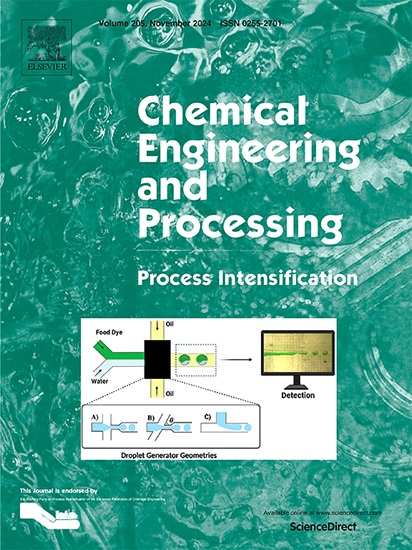Efficiency and multi-objective optimization of gas-liquid-phase mass transfer in high-viscosity fluids within heart-shaped microchannels
IF 3.8
3区 工程技术
Q3 ENERGY & FUELS
Chemical Engineering and Processing - Process Intensification
Pub Date : 2025-04-15
DOI:10.1016/j.cep.2025.110319
引用次数: 0
Abstract
Microchannels are widely utilized in the microchemical industry due to their highly efficient and enhanced mass transfer properties. However, when processing high-viscosity fluids, the flow pressure drop in microchannels significantly increases, posing challenges for system performance. To address this, it is crucial to control both mass transfer and pressure drop in gas-liquid two-phase systems in microchannels under high-viscosity conditions. This study investigates the mass transfer and flow behavior of high-viscosity fluids in heart-shaped microchannels (Advanced Flow Reactor, AFR). Experimental visualization techniques are employed to explore the effects of bubble size distribution, gas content, and pressure drop on the gas-liquid two-phase flow and its mass transfer characteristics in high-viscosity systems. A predictive model for the pressure drop in these heart-shaped microchannels is also developed. Air and high-viscosity glycerol-water solution (viscosity range of 50–320 mPa·s) are selected as the gas-liquid two-phase system. The experimental operating conditions are optimized using the enhanced multi-objective NSGA-II algorithm to identify a set of critical process parameters that balance low pressure drop with high mass transfer coefficient. The results demonstrate that compared to the liquid-phase volumetric mass transfer coefficients (Kla) at the lowest gas-phase flow rate for each viscosity, the increase in Kla is 53 %–122.7 % for viscosities ranging from 50 to 150 mPa·s. This improvement is accompanied by a 70 %–100 % increase in gas-phase flow rate and a corresponding 30 %–58 % rise in pressure drop. Optimization results indicate under ideal experimental conditions, mass transfer efficiency is enhanced, and pressure drop loss is reduced by an average of 53 %, despite a small reduction in the mass transfer coefficient. This suggests that an optimal design can effectively balance mass transfer efficiency with pressure drop reduction, offering practical solutions for high-viscosity gas-liquid two-phase systems. The findings provide a theoretical foundation for optimizing microchannel operating parameters in high-viscosity systems and achieving multi-objective optimization with low pressure drop and high mass transfer efficiency.

心形微通道内高粘度流体气液传质效率及多目标优化
微通道以其高效的传质性能在微化工领域得到了广泛的应用。然而,当处理高粘度流体时,微通道内的流动压降会显著增加,给系统性能带来挑战。为了解决这个问题,在高粘度条件下控制微通道中气液两相系统的传质和压降至关重要。本研究研究了高粘度流体在心形微通道中的传质和流动行为(先进流动反应器,AFR)。采用实验可视化技术研究了高粘度体系中气泡尺寸分布、气体含量和压降对气液两相流动及其传质特性的影响。建立了心形微通道压降的预测模型。气液两相体系选择空气和高粘度甘油-水溶液(粘度范围50 ~ 320 mPa·s)。采用增强型多目标NSGA-II算法对实验操作条件进行优化,确定了一组平衡低压降和高传质系数的关键工艺参数。结果表明:与最低气相流速下的液相体积传质系数(Kla)相比,在50 ~ 150 mPa·s范围内,Kla增加了53% ~ 122.7%;这种改善伴随着气相流量增加70% - 100%,相应的压降增加30% - 58%。优化结果表明,在理想的实验条件下,传质效率提高,压降损失平均降低53%,但传质系数略有降低。这表明,优化设计可以有效地平衡传质效率和降低压降,为高粘度气液两相系统提供实用的解决方案。研究结果为优化高粘度体系微通道运行参数,实现低压降、高传质效率的多目标优化提供了理论基础。
本文章由计算机程序翻译,如有差异,请以英文原文为准。
求助全文
约1分钟内获得全文
求助全文
来源期刊
CiteScore
7.80
自引率
9.30%
发文量
408
审稿时长
49 days
期刊介绍:
Chemical Engineering and Processing: Process Intensification is intended for practicing researchers in industry and academia, working in the field of Process Engineering and related to the subject of Process Intensification.Articles published in the Journal demonstrate how novel discoveries, developments and theories in the field of Process Engineering and in particular Process Intensification may be used for analysis and design of innovative equipment and processing methods with substantially improved sustainability, efficiency and environmental performance.

 求助内容:
求助内容: 应助结果提醒方式:
应助结果提醒方式:


